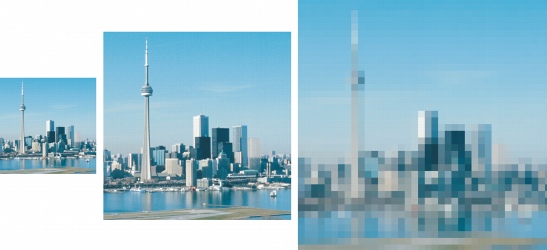Quick links to procedures on this page:
Changing image dimensions
You can change the physical dimensions of images by increasing or decreasing their height and width. When you increase image dimensions, the application inserts new pixels between existing pixels, and their colors are based on the colors of adjacent pixels. If you increase image dimensions significantly, images may appear stretched and pixelated.
The size of the image on your screen depends on the pixel height and width of the image, on the zoom level, and on your monitor settings. As a result, an image may display as a different size on your screen than when it is printed.

You can change the height and width of an image without changing the resolution. The center image is the original, the first image has smaller dimensions, and the third image has larger dimensions. Notice the pixelation of the larger image.
To change the dimensions of an image |
![]()
|
•
|
|
When you change the dimensions of an image, you produce better results using width and height values that are factors of the original values. For example, reducing an image by 50 percent produces a better-looking image than by reducing the size by 77 percent. When reducing an image by 50 percent, the application removes every other pixel; to reduce an image by 77 percent, the application must remove pixels irregularly.
|